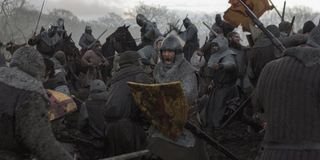What It Was Like Filming Outlaw King’s Muddy, Bloody Battle Sequences

We've seen many different kinds of war movies set throughout all eras of society, but few get as sincerely chaotic as David Mackenzie's upcoming Outlaw King. Not only is it a film featuring the execution of guerilla tactics, but the cinematography is specifically designed to highlight the insanity that is battle. It's a standout element of production, and something I got to talk about with the director and stars Aaron Taylor-Johnson and Chris Pine:
Last month I joined members of the press flying out to Edinburgh, Scotland, where I sat down with the Outlaw King director and cast to talk about the new movie. It was in both my interviews with David Mackenzie and Aaron Taylor-Johnson and Chris Pine that the subject of the chaotic battle scenes came up, and they explained how it was all brought to life.
Speaking from the actors perspective, Aaron Taylor-Johnson admitted that it was a taxing experience to create the mayhem-filled sequences of Outlaw King -- which includes a fire-filled midnight ambush, and a fight set in what's basically a giant mud pit. Tough as it was, though, it was all part of the director's vision, and that's what they signed up for. Said Taylor-Johnson,
No, it was pretty chaotic, and relentless, and grueling. And I think that's again, Mackenzie's way of filmmaking. He likes to capture that essence, and therefore creates that kind of environment where it is authentic and real and chaotic.
When I spoke with David Mackenzie later in the day, he confirmed that his personal filmmaking style isn't one that is all about structure. While making the battle sequences he had multiple cameras running, and apparently never explicitly explained to his performers what was being captured -- instead letting them just exist in the atmosphere:
Well, as the director, I like things to be very loose. I liked my actors to improvise a bit. I like to, you know, not have a very big difference between when we're on and when we're off, not really to know, and for everyone to inhabit the reality of the environment in particular location.
Outlaw King is the second collaboration between David Mackenzie and Chris Pine after their work on the Oscar-nominated Hell Or High Water. This time around Pine is playing Robert The Bruce, a noble Earl who picked up the revolutionary torch left by William Wallace in 14th century Scotland. In the name of freedom, and not wanting to live under the boot heel of England's King Edward I (Stephen Dillane), Robert led his small resistance group (including Aaron Taylor-Johnson's James Douglas, Lord of Douglas) in a battle against tyranny, waging a bloody war and being declared by his followers as the Outlaw King.
The film makes you feel like you are on the battlefield right alongside Robert The Bruce and his men, and a great deal of credit goes to the cinematographer -- who has some experience with capturing reality. As Aaron Taylor Johnson explained, it was shot by Barry Ackroyd, who not only has a background in documentaries, but also visceral thrillers like The Hurt Locker and United 93.
Barry Ackroyd shot this, and his whole background is documentary filmmaking. So it felt like we were a pack of wild animals, and it was capture what you can and there were moments of realism.
As David Mackenzie explained, there was simultaneously every effort made to make sure the set of Outlaw King was as safe as possible, including not only the stunt work, but also all of the performing with the horses. At the same time though, if you watch the film and feel like you're watching madness unfold, then that means Mackenzie accomplished his mission.
CINEMABLEND NEWSLETTER
Your Daily Blend of Entertainment News
Following its premiere earlier this fall at the Toronto International Film Festival, Outlaw King will soon be arriving for consumption -- but it won't be at your local cineplex. Instead, Netflix subscribers will find it available to stream this Friday, November 9th. Give it a watch when it lands, and be on the lookout here on CinemaBlend for more from my interviews with David Mackenzie and the movie's cast.

Eric Eisenberg is the Assistant Managing Editor at CinemaBlend. After graduating Boston University and earning a bachelor’s degree in journalism, he took a part-time job as a staff writer for CinemaBlend, and after six months was offered the opportunity to move to Los Angeles and take on a newly created West Coast Editor position. Over a decade later, he's continuing to advance his interests and expertise. In addition to conducting filmmaker interviews and contributing to the news and feature content of the site, Eric also oversees the Movie Reviews section, writes the the weekend box office report (published Sundays), and is the site's resident Stephen King expert. He has two King-related columns.
Most Popular







